Thousands of businesses have been forced to rearrange their operations as a result of the Covid 19 pandemic, and millions of workers have been forced to migrate out of the office and into a remote working environment.
Although we are all currently working mostly in this remote setting, as things start getting normal, many organizations have started opting for a hybrid strategy in which workers can work part-time from home and part-time in the office, bringing the challenge of managing hybrid teams into sharp focus.
Table of Contents
- Here’s a list of experts from a variety of fields who have shared their best tips for managing hybrid teams.
- 1. Christopher Pappas, Founder & CEO, eLearning Industry Inc.
- 2. Ryan Fyfe, COO, Insightful
- 3. Sandeep Kashyap, Founder, and CEO, ProofHub
- 4. Will Cannon, Founder, Signaturely
- 5. Yauhen Zaremba, Director of Demand Generation, Pandadoc
- 6. Ann Walton, Vice President of People & Operations, Voices
- 7. Grant Polachek, Head of Branding, Squadhelp
- 8. John Hall, Co-founder, Calendar
- 9. Admir Salcinovic,Co-founder, PriceListo
- 10. Josh Pelletier, Chief Marketing Officer, BarBend
- 11. Martin Luenendonk, CEO, FounderJar
- 12. Shaunak Amin, Co-founder/CEO, SnackMagic
- 13. Mike Grossman, CEO, GoodHire
- 14. Daniel Foley, SEO Specialist, Planday
- 15. Tytus Golas, CEO, Tidio
- 16. Payman Taei, Founder, Visme
- 17. Mark Pierce, CEO, Cloud Peak Law Group
- 18. Colin Toh, CEO, Headphonesty
- 19. Ashwini Dave, SEO Expert, Time Doctor
- 20. Amit Ghodasara, CEO, iSmartRecruit
- 21. Sunaina (Suni) Lobo, CHRO, Marqeta
- 22. Jason Morwick, Head of Remote-first, Cactus Communications
- Conclusion
1. Christopher Pappas, Founder & CEO, eLearning Industry Inc.

To manage a hybrid team effectively, you must communicate excessively. Assessing tone and emotion via digital communication channels can be more challenging, especially during a video conference. Not assume that quiet indicates agreement, particularly with more introverted coworkers.
Instead, communicate excessively and promote open, transparent dialogue. Make a point of clearly seeking feedback and following up privately if you feel a team member was uncomfortable presenting their complete perspective at a meeting. Additionally, avoid utilizing chat apps to discuss sensitive matters.
For example, if a chat thread deviates into a sensitive subject, it’s better to pause the conversation and recommend a video call or in-person discussion instead.
2. Ryan Fyfe, COO, Insightful

There are a few key things to keep in mind when managing hybrid teams effectively. The most important thing is to establish clear goals and objectives for the team and make sure everyone is on the same page. Communicate regularly and effectively, so that everyone is kept in the loop.
Be flexible in your approach, as different team members may have different working styles. Make use of technology to facilitate communication and collaboration among team members who are located in different places. Encourage team-building activities so that team members can get to know each other better and build trust within the group.
Foster a sense of community among team members, even if they’re not all in the same physical location. This can be done through regular check-ins, social events, and other bonding activities.
In order to make sure that your in-office and remote team members are on the same page, first, hold regular team meetings, either in person or via video conferencing, to keep everyone updated on project progress and deadlines. Secondly, use a project management tool to assign tasks and track progress.
Lastly, stay available to answer any questions or concerns that team members may have. By following these steps, you can help ensure that your entire team is working together towards a common goal.
3. Sandeep Kashyap, Founder, and CEO, ProofHub

These days, everyone is talking about managing remote teams. While the Covid-19 outage resulted in an increase in work-from-home employees, the end of the pandemic has resulted in the formation of hybrid teams. They’ve established themselves as the new normal, and they’re here to stay.
Leading hybrid teams necessitates paying close attention to the culture of the team. Employees who work from home may believe that individuals who work in the office have more access to the leader and other team members. Leaders should continue to hold one-on-one meetings with all team members, as they did throughout the pandemic.
Leaders should also aim to foster psychological safety in a team meeting. To do so, leaders must make a conscious effort to include all members of their team and all meeting attendees. This will aid in the development of a sense of belonging.
Apart from that, it is vital to invest in the appropriate tools and configuration for each team member’s specific scenario. This might include better Wi-Fi, headsets, and webcams for distant workers. It’s also critical to think about each team’s specific requirements. Our own tool ProofHub is used to manage both our in-house and remote teams. It assists us in staying on the same page and managing work seamlessly.
Manage your remote and in-house teams seamlessly in one place. Start your free trial now.
4. Will Cannon, Founder, Signaturely

As most work is now done on digital platforms, there is a wealth of data that can be gathered and shared to assist teams and individuals in better understanding their work patterns and how they operate best. It is super important for hybrid teams to develop a strong understanding.
Just as Fitbit provides massive data about an individual’s physical activity and health, workforce productivity and analytics solutions can provide similar insights about how people work with summaries of focus time, multi-tasking time, collaboration time, and more.
It’s now feasible to examine how changes in team norms, communication strategies, and work locations affect productivity and attention by sharing these insights with individuals and teams.
5. Yauhen Zaremba, Director of Demand Generation, Pandadoc
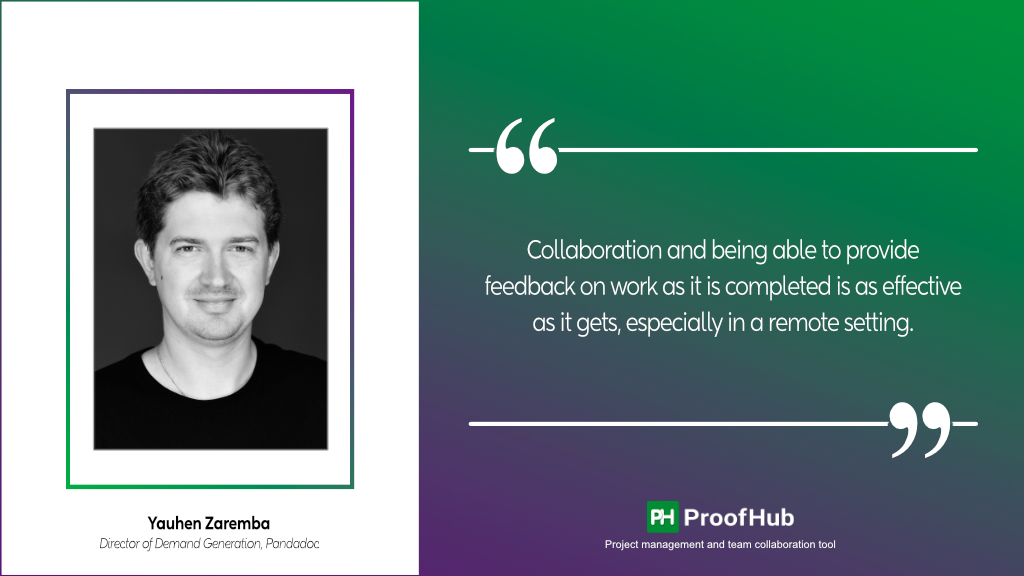
If you can find and adapt to the newest, best project management tools, then your hybrid company will barely need Zoom. Project management platforms allow managers to provide real feedback to workers, workers can learn through trial and error, and it can often be a better learning tool than virtual video chats. Collaboration and being able to provide feedback on work as it is completed is as effective as it gets, especially in a remote setting.
Once managers have looked over the work and provided feedback, then it might make sense to connect in person. This will allow you to have a more effective meeting via Zoom or in-person because you have topics ready to discuss and an agenda to cover.
Like I said above, hybrid companies need to take the introduction of new tools very seriously. These tools are strategically designed to help remote and hybrid companies work as effectively as possible and stay on the same page. Through the use of file-sharing, project collaboration, and more, companies can set up a system that allows remote workers to succeed and to create an even better work routine than ever before.”
6. Ann Walton, Vice President of People & Operations, Voices
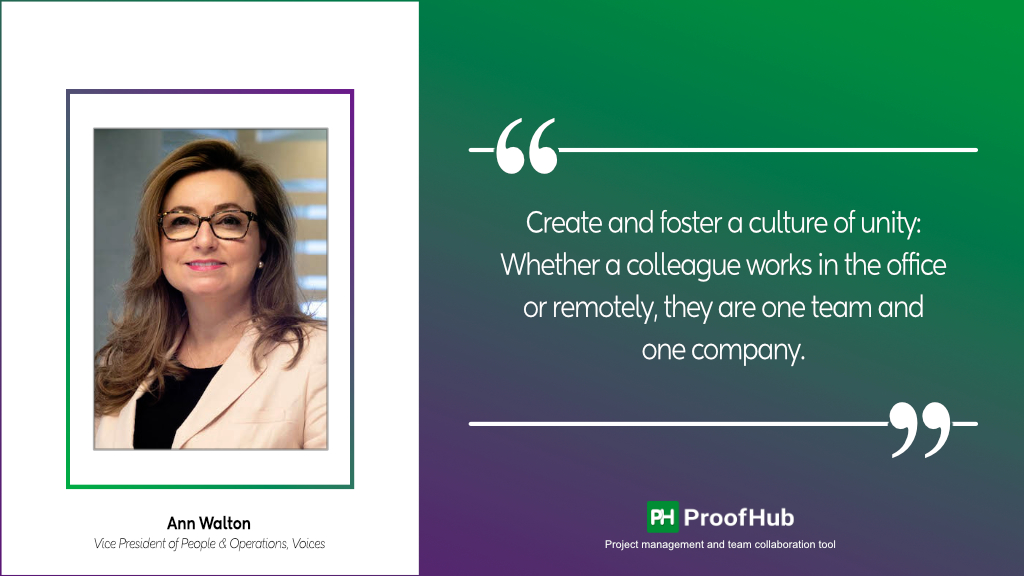
While many companies have chosen to offer a hybrid work environment, “hybrid” can mean many different things. Some organizations are offering a mix of days required in the office and days that can be worked remotely, while other companies are offering full-time work from home with the option of coming into the office if/when the employee decides to do so.
There are typically some caveats where employees may be asked to come into the office for certain meetings, training, or events. Voices offer the latter hybrid experience, meaning some of our employees choose to work fully in-office, partially in-office and partially remotely, or fully remotely.
Our key areas of focus are our colleagues’ safety and well-being, implementing effective communication strategies, and maintaining and enhancing our culture. These areas of focus are now table-stakes that must be continually revisited and improved upon. Our new hybrid environment brings forth a new set of challenges that requires intentional focus and strategies to effectively address them. Here are some of the ways we prioritize a productive and inclusive hybrid work experience:
Maintain everything you set in place for remote work: In a hybrid offering, some colleagues may choose to work from home more than they work in the office.. Don’t undo all the great remote work strategies and best practices strategies you put in place. Keep revisiting them, improving them, and measuring their effectiveness.
Ensure equitable experiences whether a colleague works in the office or remotely: While in-person interactions are inherently more conducive to building relationships, be intentionally mindful not to equate preference or value to a colleague that works in the office over a colleague that works remotely. Offer the same training and development opportunities, measure skills based on results, not familiarity, and ensure equal job opportunities are afforded to all qualified employees. This is an area where human resource partners can be especially helpful in identifying potential inequities before they occur.
Create and foster a culture of unity: Whether a colleague works in the office or remotely, they are one team and one company. Language becomes important in how we classify employees. If we start to hear “them” (remote) vs. “us” (in-office) we need to address and correct it to “us” and only “us.” There is no room for “them” to speak in our work models. Create inclusive opportunities for team building, ideation, planning, and decision-making that include remote and in-office employees. Be mindful not to default to in-office employees because you can see them and neglect the employees who are only a video call away.
7. Grant Polachek, Head of Branding, Squadhelp

If you want a hybrid team to succeed, give them the flexibility to work. This implies that when working in a hybrid model, teams should be given the autonomy to choose their working hours so that they can work at their best productive times of the day.
It also allows them to prioritize their work and fit all their commitments in a given time. Now, to ensure that everyone’s working on the same page, a project management tool can come in very handy.
This ensures that people have been given their tasks with reasonable deadlines, to which they can be held accountable. It also provides teams with a dedicated space to ideate and coordinates to bring out the best of them.
8. John Hall, Co-founder, Calendar
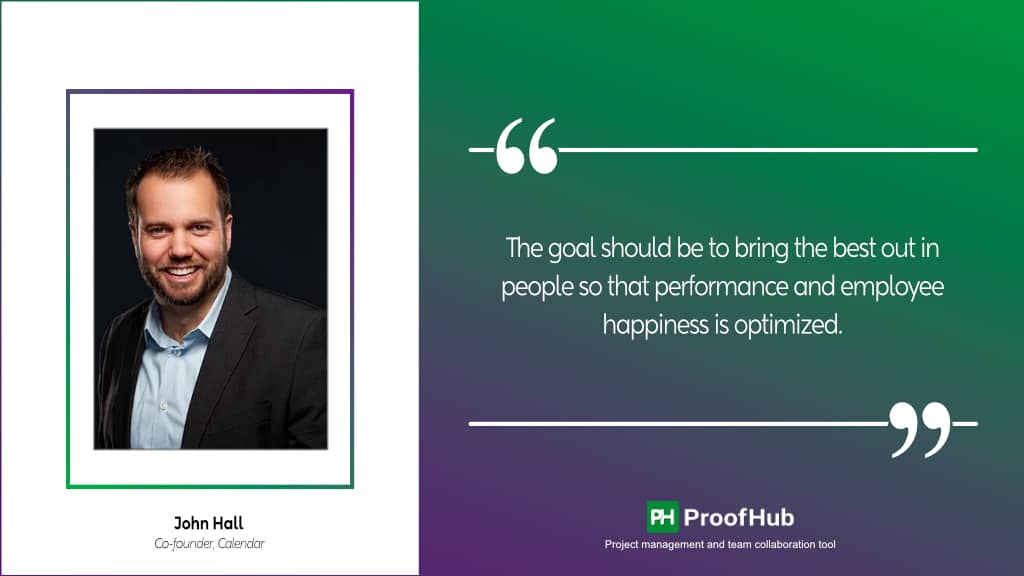
The way to manage a hybrid team is by playing to their strengths. Some employees perform best in the office and some perform with days at home. Get to know this about each employee and develop a specific plan for them. Employee A may have 4 days in the office and 1 day at home. Employee B may have 1 day in the office and 4 days at home. The goal should be to bring the best out in people so that performance and employee happiness are optimized.
In order to make sure that your in-office and remote team members are on the same page, you can have events or other ways to get them comfortable with each other. They don’t have to be best friends, but they need to feel comfortable with reaching out when they need something. If you want to get really organized you can make a RACI matrix that labels when certain tasks are done this is who you communicate with so that everybody is on the same page.
9. Admir Salcinovic,Co-founder, PriceListo

Because hybrid teams are more vulnerable to distractions when working from home, it is vital to create schedules and deadlines that keep employees more centered on tasks. For hybrid teams, work distractions, digital distractions, and personal distractions all contribute to reduced performance and productivity.
Establishing a clear schedule and deadline ensures hybrid teams remain focused and are regularly updated on tasks they need to do and when they are required to be completed. One way to make scheduling more effective is by making it binding for respective tasks.
That way, team members that get distracted can easily be called to order and ensure everyone is on the same page with regard to work progress and delivery.
10. Josh Pelletier, Chief Marketing Officer, BarBend

When managing a hybrid team, it’s important to remember that communication is key. Be sure to communicate your expectations and goals for the team, and set up regular check-ins to ensure that everyone is on the same page.
When team members are in the same physical location, communication is easy because they can talk to each other directly. However, when team members are located in different locations, communication becomes more difficult. Email, video conferencing, and teleconferencing can all be used to facilitate communication, but the best method of communication depends on the situation and the team’s preferences. If the team is located in different countries, then it may be necessary to use a combination of methods to ensure that everyone can communicate effectively.
It can also be helpful to establish specific roles and responsibilities for each member of the team so that no one feels overwhelmed or confused about what they’re supposed to be doing. And lastly, always be open to feedback and suggestions from your team members – after all, they’re the ones who are closest to the work being done.
11. Martin Luenendonk, CEO, FounderJar

The current threshold for many businesses has spread beyond the traditional location and focus of work, with the industry now seeking to include a ‘Hybrid Work Environment’ as a form of working. Creating strategies around this space could prove pivotal in adapting to the changing market conditions in the ‘Era of Remote Work’.
Try to be clear with the goals, every employee has a different work style and understanding of a command. When an organization gives a set of goals to the employees, it needs to be clear and very straight. Some employees do not completely understand what the manager means, which brings confusion and overlapping of services. Employees can mistake “quickly” for “urgently”, which can shorten their capability for that particular project. Being clear with your words, meaning, goal, and deadlines are important to keep the employees on the right path.
Always try to maintain a healthy work-life balance. There is no hard boundary between personal life and work-life anymore, as most people have been working outside of their physical work environment for quite some time now. Many companies today actively encourage this by adding flexible hours into their company’s HR policy or even making an entire ‘work from home day. This not only allows employees to be more efficient and effective at work but also allows them to spend time with their families as well.
12. Shaunak Amin, Co-founder/CEO, SnackMagic
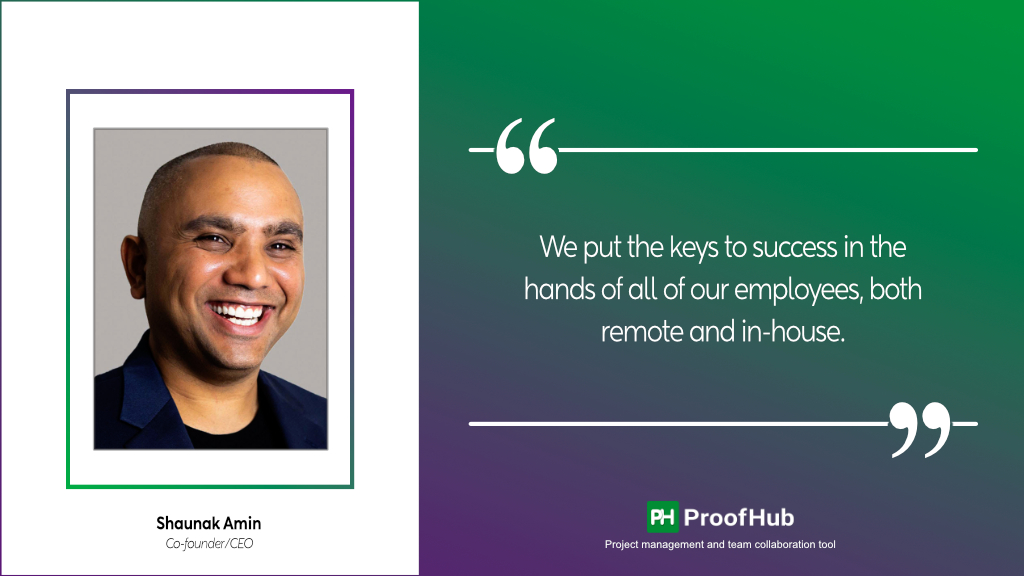
We put the keys to success in the hands of all of our employees, both remote and in-house. Our employee portal serves as a bank of information about employment at our company to help team members familiarize themselves with our organization.
It also fosters our culture by including our mission statement, story, and behind-the-scenes videos. Links to informative online books, articles, and podcasts can help develop their professional growth.
And with employee checklists, form templates, media assets, fun Zoom backgrounds, and an employee directory, our in-house, hybrid, and remote workers will all have access to the resources they need to perform well, be productive, and stay connected with the team. It also instills confidence and enables employees to take ownership of growing their careers.
But remember, designing an effective employee portal is an ongoing process. As your business is constantly improving, so too is your employee portal.
13. Mike Grossman, CEO, GoodHire
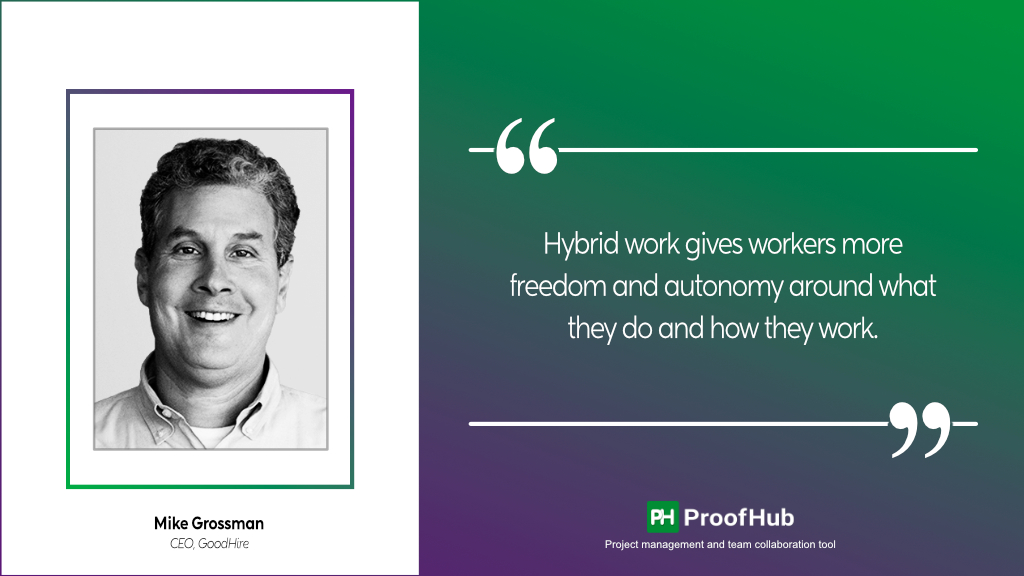
Hybrid work gives workers more freedom and autonomy around what they do and how they work. In a hybrid workplace, workers tend to enjoy greater workplace satisfaction and a healthier work-life balance. However, while hybrid work is invariably great for productivity, there are certain risks involved which tend to stem from improper management. Namely, information disparity.
Information disparity refers to situations in which access to information is unequally distributed. Where an office worker might utilize training materials, a remote worker on a personal computer might not know where to find them, or could even lack access altogether. This occurs most often when managers fail to account for a certain group of workers.
To make sure that your hybrid team operates successfully, give all workers equal access to information, support, and company resources. If you’re unsure, ask your team individually whether they’ve encountered access issues in the past. This can illuminate workflow issues that you may have otherwise missed. Armed with their perspective, you can create an experience that remains consistent both in and out of the office.
14. Daniel Foley, SEO Specialist, Planday

When your employees return to the office for the first time, they are unlikely to recognize it. Personal desks, docking stations, large computer screens, and other office items that employees are used to may be lost. Worse, connecting to Wi-Fi or a VPN can be difficult. Make certain that this does not occur. Nobody wants to get to work simply to spend the majority of the day talking to IT. Make sure that you provide your hybrid team with all the essential resources. Ensure that your office technology is easily accessible, up to date, and simple to connect to.
Commuting not only costs money (high gas prices and pricey public transportation), but it also takes time. Consider offering various types of subsidies or other measures to help reduce these costs while examining your company’s benefits program.
15. Tytus Golas, CEO, Tidio

Recently, I have noticed that many companies are trying to force their employees to go back to the office. If the CEO or managers can and want to work from the office, it doesn’t mean that everyone has to go back there. Suppose we want to introduce a hybrid system. In that case, it’s worth examining the needs of employees and not throwing out of the window the experience of working remotely during a pandemic when even the most traditional companies have introduced working completely remotely from home. Let’s face it: it is more beneficial to work from home for many people.
People have very different lifestyles, and it is impossible to accommodate them with fixed hours, especially in hybrid work. When people are free to control their time and place of work, they are much more efficient and happier about what they do. To ensure that employees are productive and satisfied with their work-life balance, a remote work strategy should include the possibility to choose where and when you work.
Employees need to be aware of what they should do and in what situations; otherwise, remote work can get very messy. Communication, reporting, and assigning tasks are crucial areas of management therefore, it is important to think about all small details and put them together in a document easily accessible to all employees. If the guidelines are clear and neat, you shouldn’t experience any problems.
It’s essential to determine what tools and resources the employees need and want to optimize their work and your budget. Plenty of software makes hybrid work easier and more convenient, so I recommend a technical dialogue where each team finds the best solutions for them. It will be worth it in the long run.
16. Payman Taei, Founder, Visme

Hybrid teams are dynamic and it requires dynamic management. Managing hybrid teams effectively is easy if you have the right tools and strategies in place. You can set clear rules and regulations for better engagement and develop daily rituals. Ensure all the team members have the right tools. Create appropriate communication channels like Slack where your team members can communicate seamlessly and easily.
Check-in with team members frequently and regularly to ensure you are on the same page and meet deadlines effectively. Be relentless about the effectiveness and set clear goals. Use technology for creating a win-win situation.
Strong communication between your in-office and remote team members will ensure they are on the same page. Conduct zoom meetings regularly to discuss the progress of the project and update the team about any new project or update at your company. Arrange meetings keeping in view the different time zones that your team members are located, so that nobody misses out. Never make office only decisions, your remote team members will feel left behind.
Stay in communication with the remote frequently and check in with their progress. It will make them feel connected and will ensure the whole team is on the same page.
17. Mark Pierce, CEO, Cloud Peak Law Group
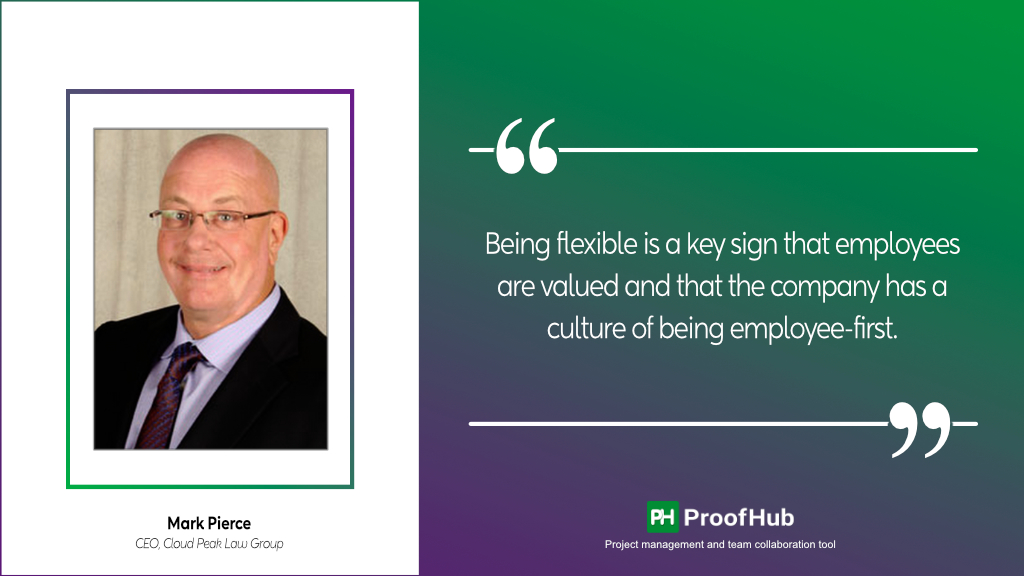
Employees can quickly become disengaged if they feel like they’re being forgotten about or ignored by their managers. You have to be deliberate in making sure to stay in contact with all employees and adapt to having check-ins remotely and in person.
Being flexible is a key sign that employees are valued and that the company has a culture of being employee-first. It also shows that the managers care about their teams, another sign of positive company culture.
An invaluable tool for us has been using Microsoft Teams to centralize our communications. A communication system needs to support both synchronous and asynchronous communication, and Teams offer ways to communicate via chat for asynchronous communication and video for real-time communication.
The best way to support hybrid employees is to ensure that they can communicate easily with colleagues and managers from wherever they’re working.
18. Colin Toh, CEO, Headphonesty

To manage hybrid teams effectively, you need to ensure that you’re giving both in-office and remote employees equal amounts of attention. This helps to alleviate the possibility of you spending more time with the employees who work in the same location you do and unintentionally neglecting those who don’t.
To make sure that office and remote team members are on the same page, create a set of working guidelines that help people stay connected from wherever they’re working from.
The guidelines should include communication norms (how is information shared across locations, what is the best way to stay in contact, etc) expectations of working times (blocks of time to be available for meetings regardless of work location, ‘power hours for collaboration, etc), and general workplace best practices so that everyone abiding by the same set of rules.
19. Ashwini Dave, SEO Expert, Time Doctor
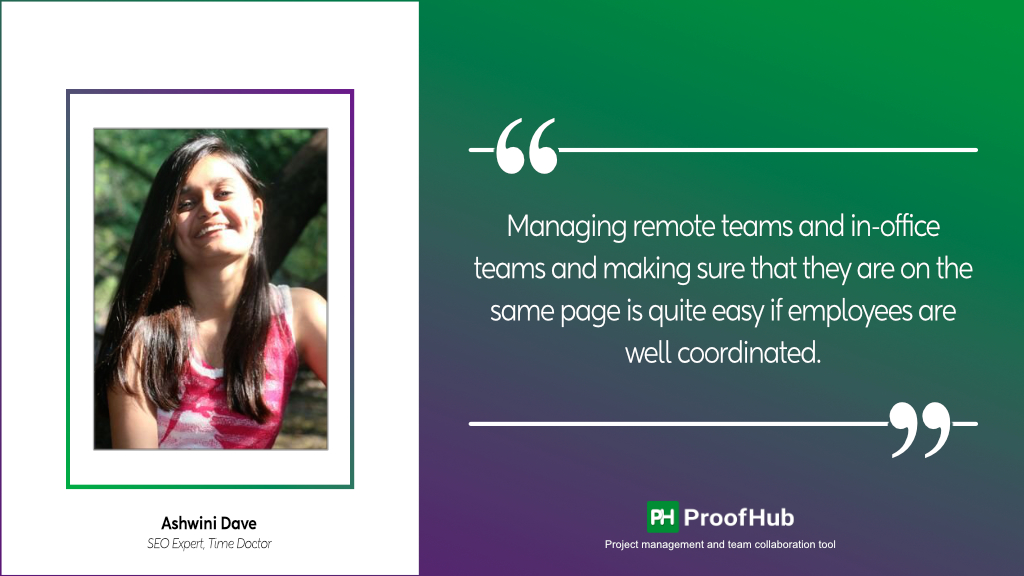
Managing hybrid teams effectively needs a well-planned strategy if one has never handled it before. Keeping employees motivated and productive at the same time should be the motto. I think time tracking software can be the most helpful tool in the remote era to manage your hybrid team. It helps to monitor all the activities, and the time they spend on each activity. It also helps in analyzing how productive employees are during work hours.
Also, it helps with payment calculations. On the other side, it also helps employees to track their time better and manage their schedules accordingly. Time tracking software is the best solution for many problems in managing a hybrid team.
Managing remote teams and in-office teams and making sure that they are on the same page is quite easy if employees are well coordinated. Holding a video meeting with cameras on can help in better coordination. Using different communication forms and encouraging questioning in employees can be another way.
Also, ensure the leadership and management team are easily accessible when employees need them. Conducting regular surveys helps to identify the problems both remote and office teams are facing. Ask both teams to share their schedule regularly for better communication.
20. Amit Ghodasara, CEO, iSmartRecruit

As the biggest challenge has turned into the biggest opportunity, the Pandemic brought a revolutionary trend in the work model and hence hybrid work model has come into existence where the flexibility of employees to work remotely or from offices has resulted in boosting productivity and satisfaction.
Apart from the numerous benefits of the hybrid work model, Leading hybrid teams with more accuracy has become a challenge for every leader. Considering this today’s fact we have identified the best tips that help manage your hybrid teams effectively.
Setting up clear expectations and goals for your team helps your team to work with more focus and simultaneously the team performance will enable you to contribute to overall success.
Effective medium for streaming communication with your hybrid teams becomes essential since video conferences, team-building activities, and interactive sessions all are important to engage your team and increase effectiveness.
Documenting general information such as company policies, rules & regulations, Instructions to use important tools, basic work-related knowledge in a way that can be easily accessible for any employees especially those who have recently.
While working in a team; the interests and preferences of each team member use to be different from others hence making a balance with identifying the interests and needs of your team members makes hybrid work more effective.
Encourage your team to perform every task whenever they are assigned, maintaining schedules that will make employees learn new skills regularly with tracking tools, It will eventually help the hybrid teams to be more productive.
So, If you are a manager or team leader who is managing big hybrid teams, Taking note of the above tips will surely make your responsibilities less challenging.
On one hand, changing the trend in working patterns has allowed every employee to work remotely at any location, while on another hand it has also challenged the managers to continuously track the progress of their remote team members.
Make sure that all the important updates, as well as announcements, are notified to every remote team member explicitly.
Imitate fringe benefits to remote team members whenever celebrating together, e.g. If you have planned team lunch then the remote team members should get the benefit of the same being at their locations or getting paid for the expense. This will motivate them to be more engaged and productive.
As communication plays a vital role in terms of achieving a common goal, hence adopting various technical tools for immediate communication with remote team members helps sync them with in-office team members, for e.g slack is a tool where all the team members can be continuously active for communications and transferring information. Managing a schedule and working hours for in-office team members along with remote workers in a way that does not overburden any of the team members.
21. Sunaina (Suni) Lobo, CHRO, Marqeta

There isn’t a one-size-fits-all approach to building a strong hybrid culture, but there are a few tactics that can make an impact. Companies should prioritize open communication and transparency, starting with leadership.
This is the foundation for building trust and keeping morale high across the organization. We also see how employees thrive when they have a sense of belonging and a strong community around them. In a hybrid workforce, Employee Resource Groups (ERGs) are more important than ever. They provide an open space for employees from underrepresented backgrounds to connect and empower each other.
At Marqeta, we host various ERG-led virtual events, such as DJ sessions, talent shows, and trivia nights, to keep that connection alive across the company. Companies should also encourage smaller in-person social events. Whether it’s individual teams or remote colleagues from the same city meeting up, building camaraderie outside of the day-to-day meetings is so important in helping to transition successfully into a hybrid workforce.
22. Jason Morwick, Head of Remote-first, Cactus Communications
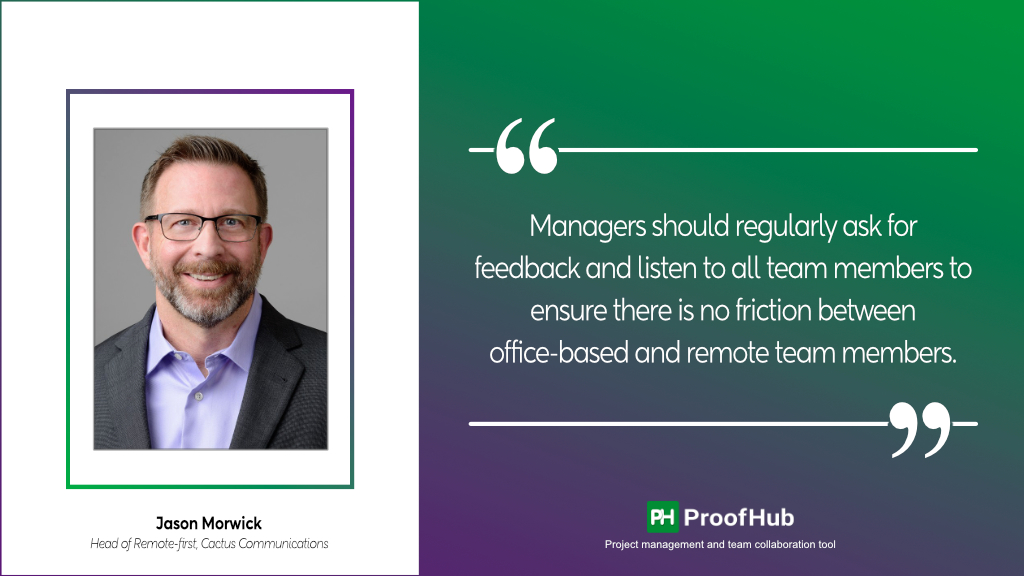
Establish team norms or expectations within the team. Are there core work hours or is the team expected to be available at certain times of the day? Do you expect remote team members to be on video during meetings? What are the preferred tools (i.e. text, chat, email, meeting) to communicate? Creating some basic expectations around how the team should work together can prevent conflicts down the road.
Document, document, document. In an office setting, it’s natural for team members to have spontaneous conversations. This can be helpful to build social connections within the team. However, realize that remote team members are not privy to impromptu work-related discussions in the office. Hybrid team managers must learn to get in the habit of documenting discussions and actions that happen in the office and ensure remote team members are aware.
Actively listen and solicit feedback. Perceptions of bias can be easily created in a hybrid environment if a manager is office-based or has a preference to work in the office. Managers should regularly ask for feedback and listen to all team members to ensure there is no friction between office-based and remote team members.
Bring all of your team’s tasks, communication, files, and deadlines under one roof. Sign up NOW.
Conclusion
While there’s a lot more to say about investing in team members as individuals and promoting constructive team cooperation, these expert ideas should help you overcome some of the most typical roadblocks to success.
Hybrid teams are here to stay, so as leaders, we should keep developing our skills to manage, engage, and build a great culture regardless of where they work from.
